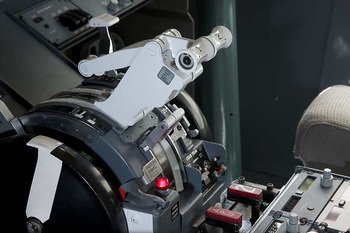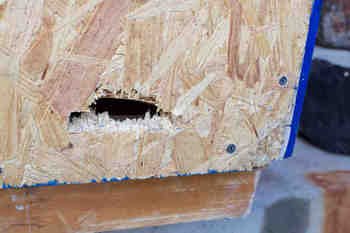B737 Throttle Quadrant - Trim Wheels and Trim Indicator Tabs
/Captain-side trim wheel and trim tab indicator. I was fortunate that the throttle unit I aquired retained its light plates in excellent condition. It's not uncommon to find that the light plates are faded, scratched and cracked from removal of the unit from the aircraft
This post, the third last concerning the throttle quadrant conversion, will discuss the spinning of the trim wheels and movement of the trim tab indicators; both integral components of the throttle quadrant. For a list of articles about the conversion of the throttle quadrant, see the bottom of this page.
1: TRIM WHEELS
The trim wheels were implemented by Boeing in the mid 1950’s with the introduction of the Boeing 707 aircraft and been a part of the flight deck ever since. The main reason Boeing has continued the use of this system in contrast with other manufacturer, who have removed the spinning trim wheels is redundancy. Boeing believes that the flight crew should have the ability to manually alter trim should a number of cascading failures occur.
Whatever the reason for Boeing continuing with this older style technology, many flight crews have learnt to “hate “ the spinning trim wheels. They are noisy and distracting, not to mention dangerous if a flight crew accidentally leaves the handle in the extended position; there is a reason that they are called “knee knockers”.
Many virtual pilots are accustomed to using manual trim when flying a Cessna or a small twin such as the King Air. In such aircraft altering trim by hand is straightforward and a necessary part of trimming the aircraft. However, a jet such as the B737 it is a tad different; to alter the trim by hand would require the flight crew to manually rotate the trim wheels several dozen times to notice any appreciable result in trim. As such, the electric trim switches on the yokes are mainly used to alter trim.
Motors, Interface Cards and Speed of Trim Wheel
The power to spin the trim wheels comes from two 12 Volt DC pump motors installed within the throttle unit. A Phidget High Current AC Controller card is used to interface the trim wheels to the flight avionics software (proSim737). The cards are located in the Interface Master Module (IMM) and connected to the throttle unit by customised VGA cables.
The trim wheels can spin at two speeds. The autopilot producing a different speed to that of manual trim (no automation selected). A Phidget card is used to control the variability, with each of the two channels programmed to a different speed. To alter the actual revolutions of the trim wheel, each channel is accessible directly from within the ProSim737 software configuration.
To allow the trim system to be used by CMD A and/or CMD B, a second card is installed to ensure duplicity.
Correct Timing
The trim wheels have white longitudinal line painted on each trim wheel. This line serves two purposes: as a visual reference when the trims wheels are spinning, and to determine the number of revolutions per second during calibration. To ascertain the correct number of wheel revolutions per second, a digital tachometer is used in the same way a mechanic would tune an older style motor vehicle.
Out of interest, in manual trim, 250 revolutions of the trim wheels are necessary to move the trim tab indicators from full up to full down.
Two Speed or Four ?
The B737 has four different trim revolution speeds, each speed dependent upon the level of automation used and the radio altitude the aircraft is above the ground.
Although it is possible to program this logic into the Alpha Quadrant cards and bypass ProSim737 software entirely (closed system), it was decided not to as the difference in two of the four speeds is marginal and probably unnoticeable. Further, the level of complexity increases somewhat programming four speeds.
Autopilot mode rotates the trim wheels at a faster rate than when in manual trim.
Trim wheel removed showing heavy duty spline shaft
Trim Wheel Braking
The real 737 incorporates a braking mechanism on the trim wheels that inhibits wheel movement when there is no input received to the system from either the auto pilot or electric trim switches. The brake operates by electromagnetic radiation and is always on, being released when an input is received.
An unsuccessful attempt was made to replicate this using two military specification high torque brake motors. The motors incorporate a brake mechanism, but the torque was so high and the breaking potential so great, that when the brake was reengaging/disengaging there was a loud thud that could not be ignored. Further, the motor became very hot when the brake system was engaged and vibrated excessively due to its high power rating.
At the time, a lower torque motor could not be procured and a decision was made to use the 12 volt pump motors. Therefore; the trim wheels take an extra second or so to spin down – not a major imposition and barely noticeable when flying the aircraft..
Deactivating Trim Wheel Spinning
Most of my virtual flying is at night and noisy and vibrating trim wheels can easily aggravate others in the house attempting to sleep. To allow easy disconnection of the trim wheels, I have configured the right side trim stabilizer toggle to cut the power to the trim wheels. Although not authentic, sometimes minor alterations need to be made to a system to make it more user friendly.
2: TRIM TAB INDICATOR MOVEMENT
The trim tab indicators are used as a visual reference to indicate to the flight crew the trim of the aircraft. The trim and subsequent movement of the indicator tabs are activated either by depressing the electric trim switch on the yoke or by turning the trim wheels by hand.
Phidget Card
A Phidget Motor Controller Advanced Servo card and servo is used to control the movement of the two trim tab indicators, while the logic to activate the servo is directly from the flight avionics software. The speed that the trim tabs move is set through ProSim737 (trim speed).
Aluminum tab connected to servo. Servo is mounted behind aluminium plate. You can just make out the screw wire between the servo and the tab
Hardware Modifications
To allow the servo to connect directly to the trim tab indicators, a small tab of aluminium was welded to the main trim tab shaft. A thin screw wire was then connected from the servo to the tab to allow nay movement of the trim tab to be registered by the servo.
Determining Accuracy
There is little point in implementing movement of the trim tab indicators if a high level of accuracy is not possible; therefore, it’s important that that the position of the tabs matches that of the flight avionics software and virtual aircraft. To ensure positional accuracy and maintain repeatability the servo was calibrated throughout its range of movement and checked against the “virtual trim tab strip” that can be placed on the EICAS screen within the ProSim737 software.
The short video below shows the smoothness in movement of the trim tab indicators. You will note the TQ vibrates somewhat. This is because I have yet to secure it to the platform.
Navigate to 737 Throttle Quadrant for a detailed list on throttle quadrant articles.














































